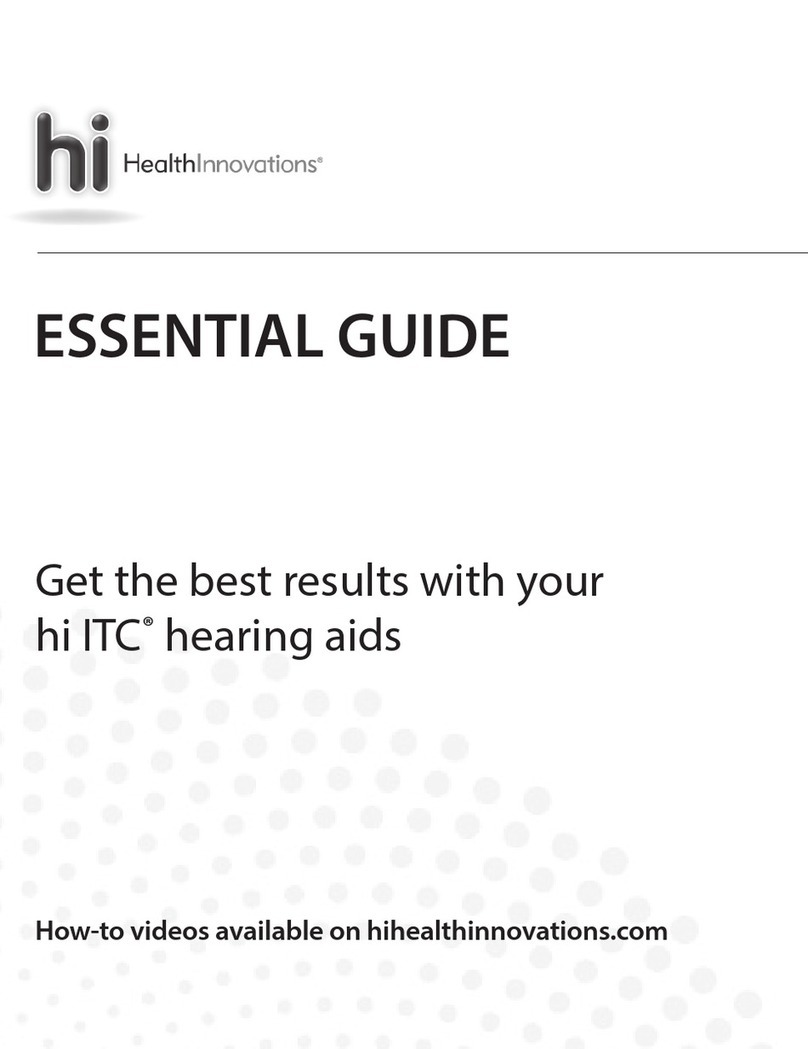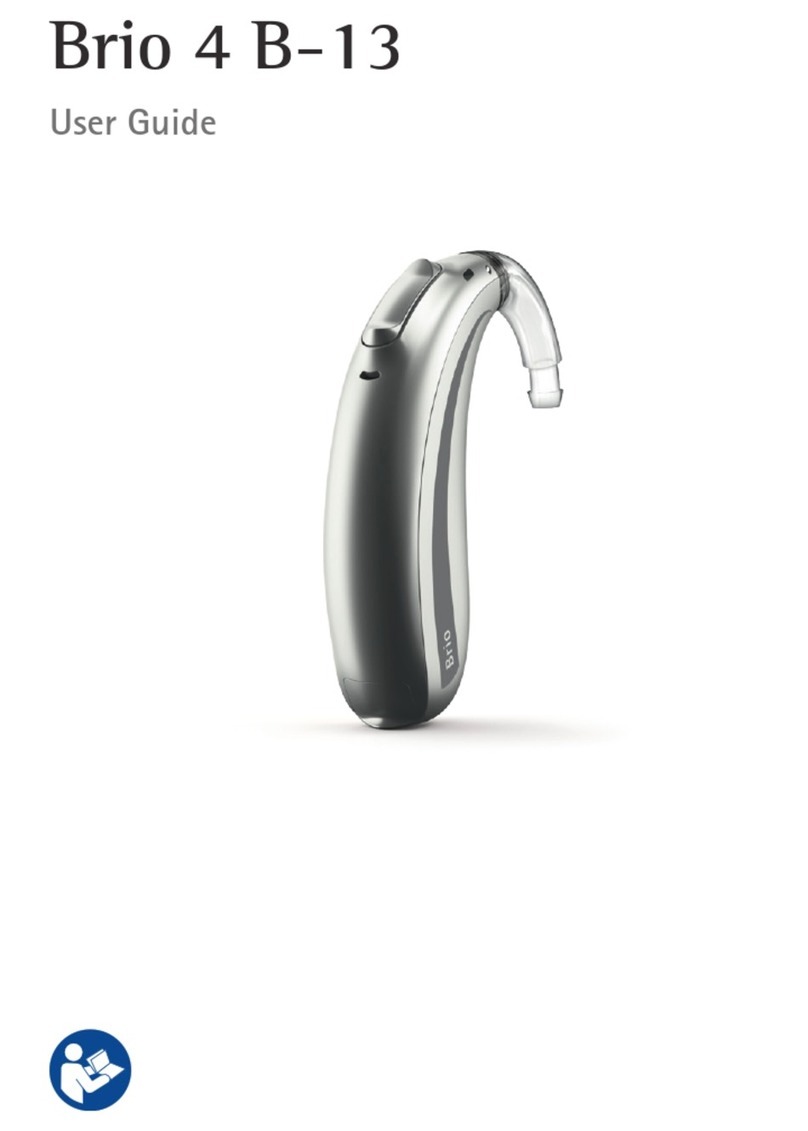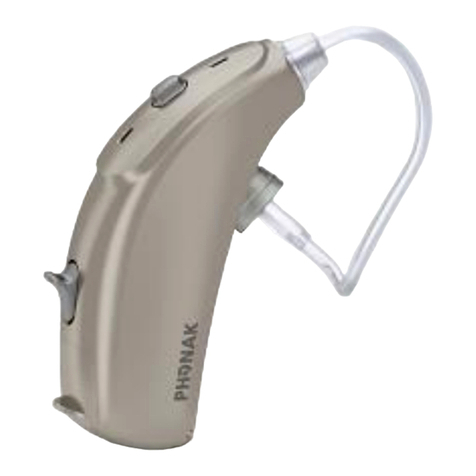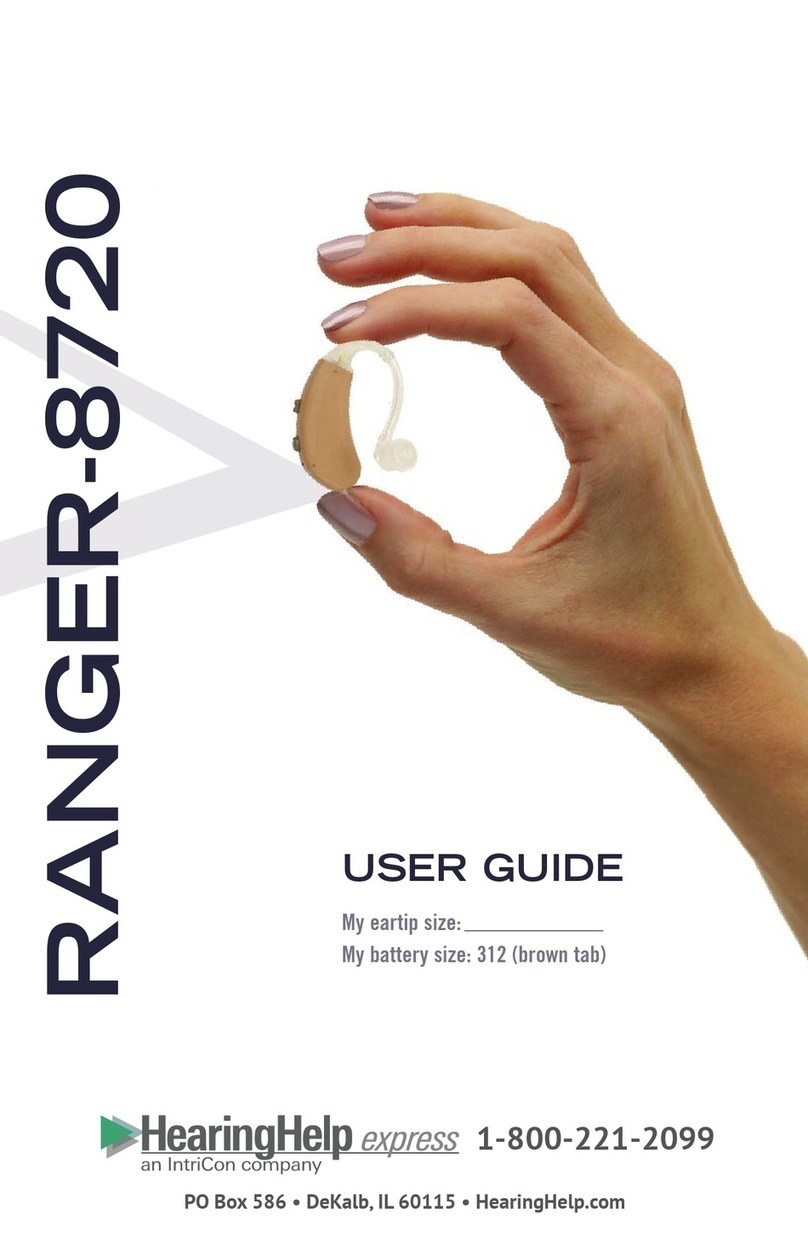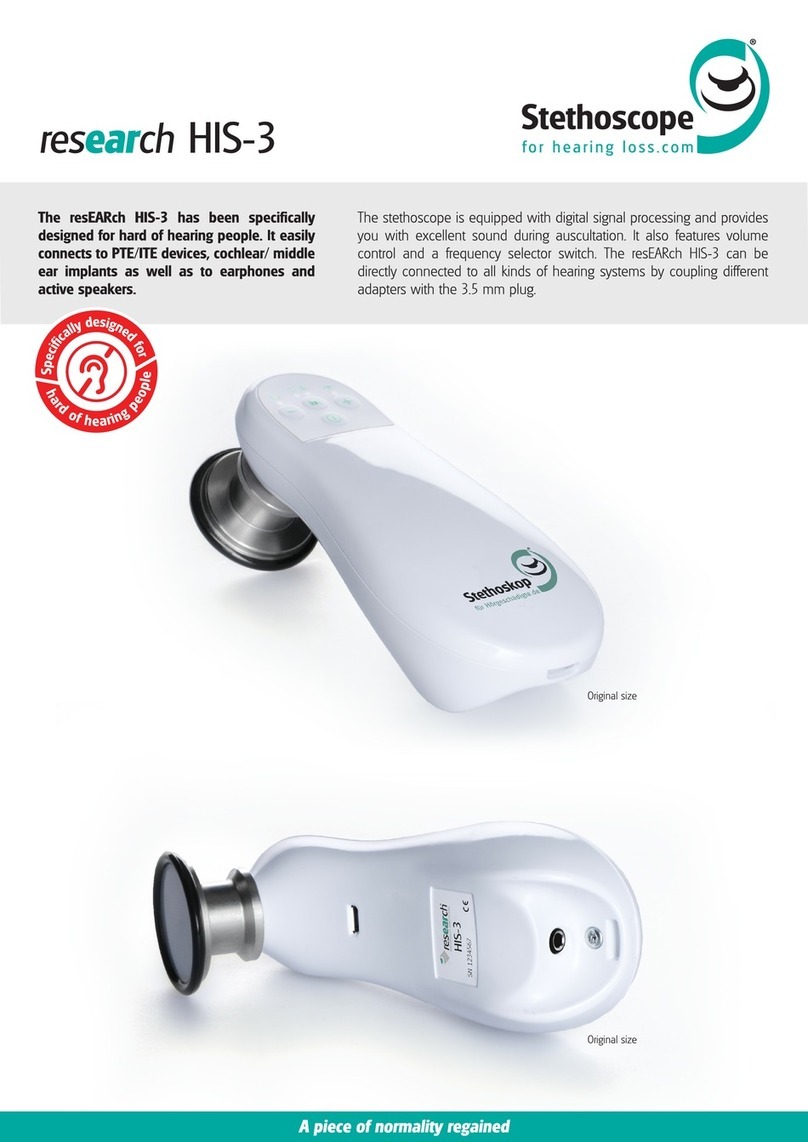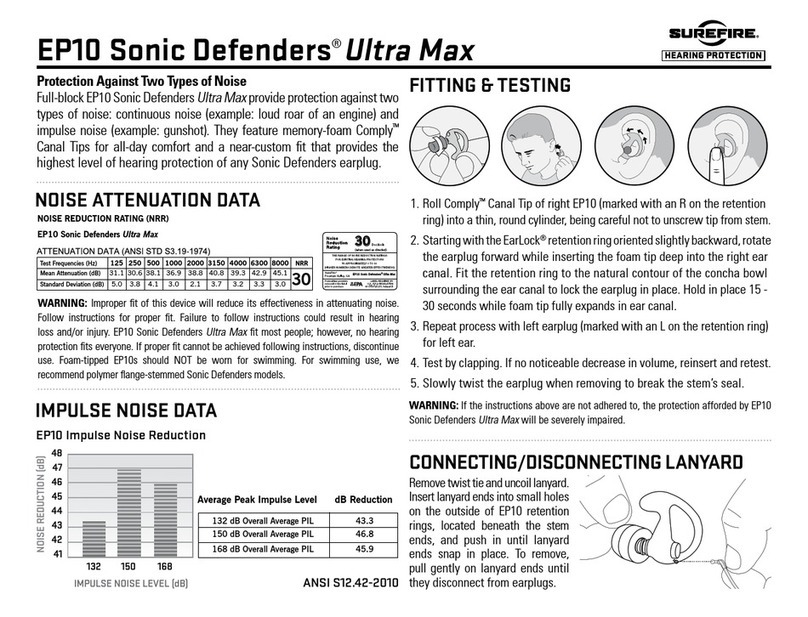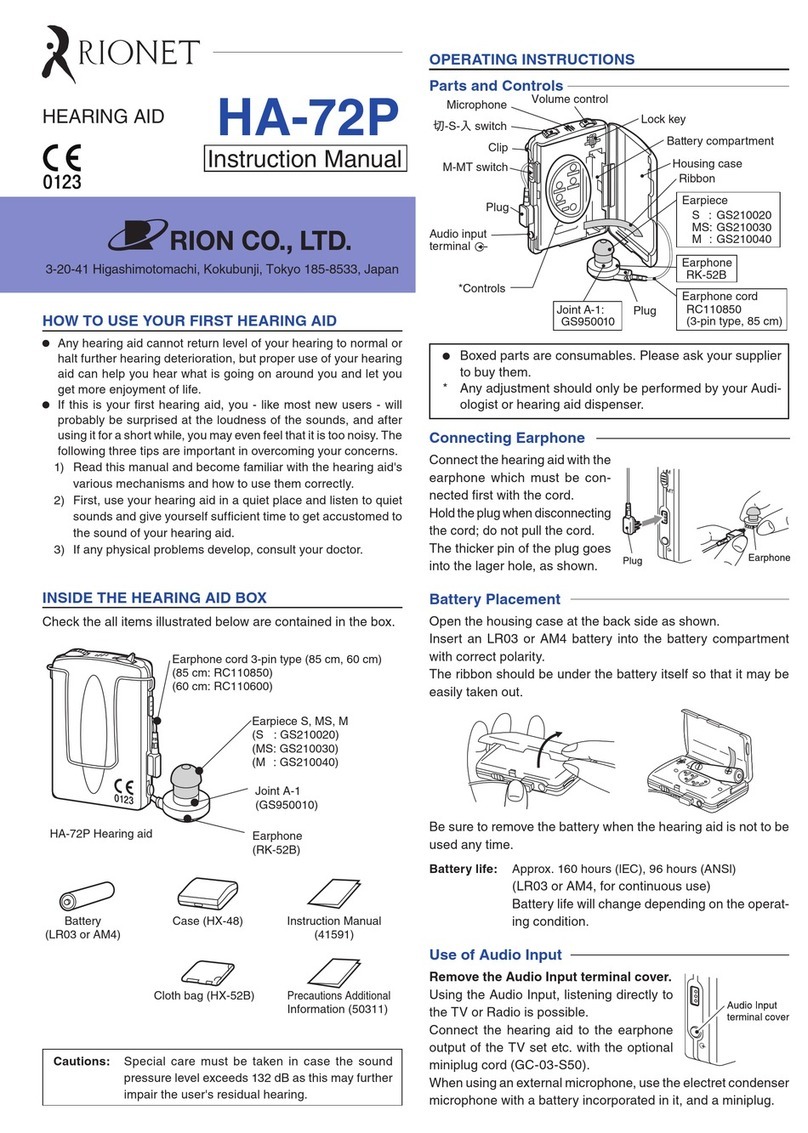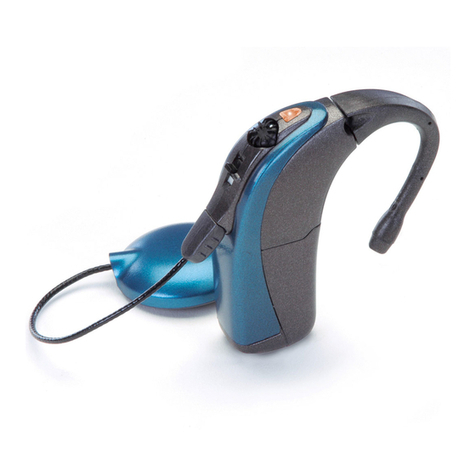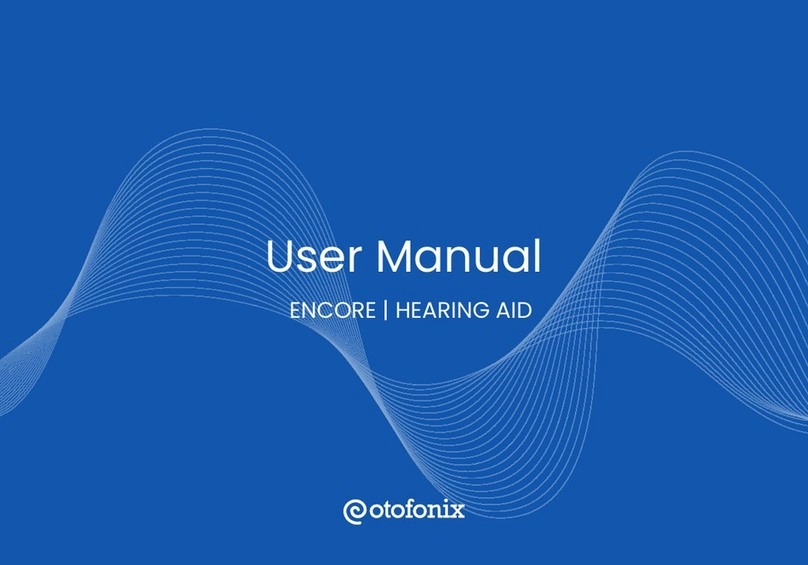Indications for Use
The hearing instrument is intended to amplify and transmit
sound to the ear and thereby compensate for mild to
moderate–to–severe impaired hearing.
Usage of hearing instruments
• Hearing instruments should be used only as directed and
adjusted by your Hearing Care Professional. Misuse can
result in sudden and permanent hearing loss.
• Never allow others to wear your hearing instrument as
incorrect usage could cause permanent damage to their
hearing.
Choking hazards
• Hearing instruments, their parts, and batteries are not toys and
should be kept out of reach of children and anyone who might
swallow these items or otherwise cause injury to themselves.
Avoiding heat and chemicals
Your hearing instrument must never be exposed to extreme
heat e.g. left inside a parked car in the sun. It must not be
dried in microwave ovens or other ovens.
The chemicals in cosmetics, hairspray, perfume, after shave
lotion, suntan lotion and insect repellent can damage your
hearing instrument. You should always remove your hearing
instrument before applying such products and allow time for
the product to dry before putting on your hearing instrument.
If you use lotion, be sure to dry your hands before using your
hearing instrument.
Mobile phone
Some hearing instrument users have reported a buzzing
sound in their hearing instrument when they are using mobile
phones, indicating that the mobile phone and hearing
instrument may not be compatible.
According to the ANSI C63.19 standard (ANSI C63.19–2007
American National Standard Methods of Measurement of
Compatibility Between Wireless Communications Devices and
Hearing Aids), the compatibility of a particular hearing aid and
mobile phone can be predicted by adding the rating for the
hearing aid immunity to the rating for the mobile phone
emissions. For example, the sum of a hearing aid rating of 2
(M2/T2) and a telephone rating of 3 (M3/T3) would result in a
combined rating of 5. Any combined rating that equals at least
5 would provide “normal use”; a combined rating of 6 or
greater would indicate “excellent performance”.
The immunity of this hearing instrument is M3/T3.
The equipment performance measurements, categories and
system classifications are based upon the best information
available but cannot guarantee that all users will be satisfied.
IMPORTANT NOTICE
The performance of individual hearing instruments may
vary with individual mobile phones. Therefore, please try
this hearing instrument with your mobile phone or, if you
are purchasing a new phone, be sure to try it with your
hearing instrument prior to purchase. For additional
guidance, please ask your mobile phone provider for the
booklet entitled “Hearing Aid Compatibility with Digital
Wireless Mobile Phones.”
Technical information
The hearing instrument contains a radio transmitter using
short range magnetic induction technology working at 3.84
MHz. The magnetic field strength of the transmitter is < -42
dBμA/m @ 10m.
The emission power from the radio system is well below
international emission limits for human exposure. For
comparison, the radiation of the hearing instrument is lower
than unintended electromagnetic radiation from for example
halogen lamps, computer monitors, dishwashers etc. The
hearing instrument complies with international standards
concerning Electromagnetic Compatibility. Due to the limited
space available on the instruments all relevant approval
markings are found in this document.
N1175
Waste from electronic
equipment must be
handled according to
local regulations.
The hearing instrument contains a module with:
FCC ID: U28FU2BTERIT
IC: 1350B-FU2BTERIT
The device complies with Part 15 of the FCC rules and
RSS-210 of Industry Canada.
Operation is subject to the following two conditions:
1. this device may not cause harmful interference.
2. this device must accept any interference received,
including interference that may cause undesired
operation.
Changes or modifications not expressly approved by the party
responsible for compliance could void the user’s authority to
operate the equipment.International warranty
International Warranty
Your hearing instrument are covered by a limited warranty
issued by the manufacturer for a period of 12 months from
the date of delivery. This limited warranty covers manufactur-
ing and material defects in the hearing instrument itself, but
not accessories such as batteries, tubing, ear wax filters etc.
Problems arising from improper handling or care, excessive
use, accidents, repairs made by an unauthorized party,
exposure to corrosive conditions, physical changes in your
ear, damage due to foreign objects entering the device, or
incorrect adjustments are NOT covered by the limited
warranty and may void it.
The above warranty does not affect any legal rights that you
might have under applicable national legislation governing
sale of consumer goods. Your Hearing Care Professional may
have issued a warranty that goes beyond the clauses of this
limited warranty. Please consult him/her for further
information.
If you need service
Take your hearing instrument to your Hearing Care Professional,
who may well be able to sort out minor problems and
adjustments on the spot.
Oticon declares that this hearing instrument is in compliance
with the essential requirements and other relevant provisions
of Directive 1999/5/EC.
Declaration of comformity is available at:
Oticon A/S
Kongebakken 9
DK-2765 Smørum
Denmark
www.oticon.com
miniRITE
INSTRUCTIONS FOR USE
• Never replace the battery or adjust the controls of the
hearing instrument in front of infants, small children or
people with learning diculties.
• Discard batteries carefully in a place where infants, small
children or people with learning diculties cannot reach
them.
• Batteries have occasionally been mistaken for pills. Therefore
check your medicine carefully before swallowing any pills.
• Never put your hearing instrument or batteries in your mouth
for any reason, as they are slippery and could be swallowed
by accident.
• Most hearing instruments can be supplied with a tamper-
resistant battery compartment upon request. This is
strongly recommended for infants, small children, and
people with learning diculties.
If a battery or hearing instrument is swallowed, see a doctor
immediately.
Battery use
• Always use batteries recommended by your Hearing Care
Professional. Batteries of low quality may leak and cause
bodily harm.
• Never attempt to recharge your batteries. They may
explode and cause serious injury.
• Never dispose of batteries by burning them. There is a risk
that they will explode and cause serious injury.
Dysfunction in hearing instruments
• Hearing instruments may stop functioning, for instance if
the batteries have expired or if the speaker is blocked by
moisture or ear wax. You should be aware of this possibility,
in particular when you are in trac or otherwise dependent
on warning sounds.
Active implants
• If you wear an active implant, then keep the hearing
instrument more than 15 cm away from the implant e.g.
do not carry them in a breast pocket.
• If you have an active brain implant, please contact the
manufacturer of your implantable device for information
about the risk of disturbance.
• The included case for instrument storage may have a built-
in magnet. If so, and you have an implantable device, such
as pacemakers or debrillators, the instrument case should
not be carried in a chest pocket or near to the chest.
If you are in doubt of details of your instrument case, contact your
Hearing Care Professional.
Explosives
• The power source in your hearing instrument has
insucient energy to cause re in normal conditions of use.
The hearing instrument has not been tested for compliance
with international standards concerning explosive
atmospheres. It is recommended not to use your hearing
instrument in areas where there is a danger of explosions.
X-ray, CT, MR, PET scanning and
electrotherapy
• Remove your hearing instrument for example during X-ray,
CT / MR / PET scanning electrotherapy or surgery as your
hearing instrument may be damaged when exposed to
strong elds.
Power instrument
• Special care should be exercised in selecting, tting
and using a hearing instrument where maximum sound
pressure capability exceeds 132 dB SPL (IEC 711), as there
may be risk of impairing the remaining hearing of the
hearing instrument user.
Possible side effects
• Hearing instruments, moulds or domes may cause an
accelerated accumulation of ear wax.
• The otherwise non-allergenic materials used in hearing
instruments may in rare cases cause a skin irritation or any
other unusual condition.
Please seek consultation with a physician if these conditions occur.
Interference
• Your hearing instrument has been thoroughly tested for
inter-ference, according to the most stringent international
standards. However, interference with your hearing instru-
ment and other devices may occur, for example for some
mobile telephones, citizens band devices and shop alarm
systems. If this occur increase the distance between the
hearing instrument and the device.
Wax filter
• Always visually inspect your hearing instrument to ensure
that there is no gap between the wax protection flange and
the tip of the mould.
If you are in any doubt of the use or replacement of your wax filter,
contact your Hearing Care Professional.
Water resistance
Your new Oticon hearing instrument is water resistant.
Although your hearing instrument has achieved an IP57*
classification, it is referred to as being water resistant, not
waterproof.
Should your hearing instrument get in contact with water and
stop working, please follow these guidelines:
• Gently wipe o any water on the outside of the instrument
• Open the battery drawer and remove the battery
• Gently wipe o any water in the battery compartment
• Let the hearing instrument dry with the battery
compartment left open for approx. 30 minutes
• Insert a new fresh battery – and your hearing instrument
should work normally again
Using an anti-humidity kit can help to avoid these problems
and may even extend the life of you hearing instrument.
Consult your Hearing Care Professional for further advice.
*IP Code classies and rates the degrees of protection provided
against the intrusion of solid objects (including body parts
like hands and ngers), dust, accidental contact, and water in
mechanical casings and with electrical enclosures 0543 0682
IMPORTANT NOTICE
You should familiarise yourself fully with the following
general warnings and the entire content of this pamphlet
before using your hearing instrument.
CAUTION
The miniRITE Power is a powerful hearing instrument. If you
are fitted with miniRITE Power, you should never allow others
to wear your hearing instrument, as incorrect or wrongful
usage could cause permanent damage to their hearing.
134801UK / 12.13
Spirit Synergy
People First
Warnings
People First is our promise
to empower people
to communicate freely,
interact naturally and
participate actively
0000134801000001
IMPORTANT NOTICE
• Do not wear your hearing instrument while showering
• Do not wear your hearing instrument while swimming,
snorkeling or diving, as it is not designed for such activities
• Do not immerse your hearing instrument in water or
other liquids





